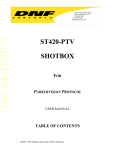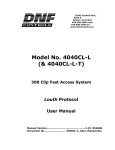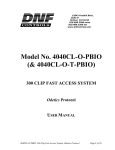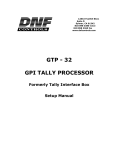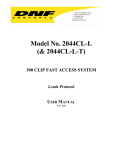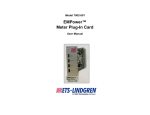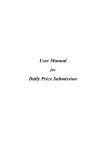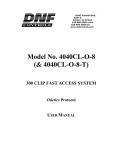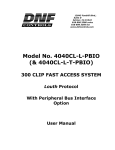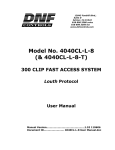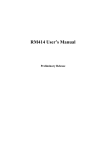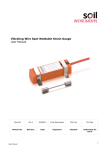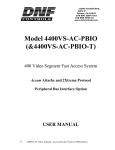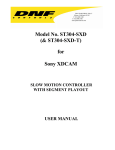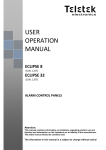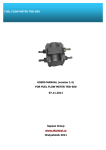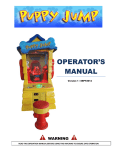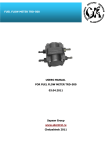Download Model No. ST400-CP
Transcript
12843 Foothill Blvd., Suite D Sylmar, CA 91342 818 898 3380 voice 818 898 3360 fax www.dnfcontrols.com Model No. ST400-CP Protocol Description & USER MANUAL ST400-CP User Manual Page 1 of 19 Table of Contents _____________________________________________________________________________________________ 1. REVISION HISTORY 3 2. OVERVIEW 4 a. b. DESCRIPTION FUNCTION CHART 4 5 3. INSTALLATION 5 4. POWER UP DEFAULTS 9 5. PROTOCOL DESCRIPTION 9 a. b. c. d. COMMUNICATIONS FORMAT COMMANDS CONFIGURATION TABLES COMMAND EXAMPLES 6. SPECIFICATIONS 9 9 14 16 17 POWER CONNECTOR SP2 Connector, RS232 PINOUT SP2 Connector, RS422 PINOUT 17 17 17 7. KEY LAYOUT 18 8. DNF CONTROLS LIMITED WARRANTY 19 Manual Version …………..…….……………… 1.4 073004 Document No. …….…….……. ST400-CP User Manual.doc ST400-CP User Manual Page 2 of 19 1. REVISION HISTORY 122203 Rev. 1.0 Original Document 010804 Rev. 1.1 Added Highlight Byte to the LCD command. 012304 Rev 1.2 Added RS422 Controller jumper configuration 071304 Rev 1.3 Added “I” command to draw tables. 073004 Rev. 1.4 Added “P” command to clear a part of the display. ST400-CP User Manual Page 3 of 19 2. OVERVIEW a. DESCRIPTION The ST400 will operate as an event driven device, transmitting information to the External Control System (ECS) when a change is detected. In addition, the ECS may poll the ST400-CP at any time for current status information. Key Press Decoding The ST400 will automatically detect and decode changes in the state of its 46 keys. It will return the state of all keys on the keyboard any time there is a change detected. The state of the keyboard is returned as 12 bytes, 6 bytes for Key Change bitmap (each key is represented by a bit) and 6 bytes for Key State bitmap of the key (each key is represented by a bit). If a bit is set in the Key Change Bitmap – the corresponding key’s state was changed. If a bit is cleared in the Key Change Bitmap, the corresponding key’s state was not changed. If a bit in the Key State bitmap is set – the corresponding key is pressed. If the bit is cleared, the corresponding key is released. Key LEDs The Key LEDs are controlled by the ECS. Using appropriate commands, each led may be individually controlled, turned ON or OFF. The ECS sends a five (5) byte, bit mapped value to the ST400 to control the state of each LED. When a bit is set, the LED is turned on. When a bit is cleared, the LED is turned off. LCD Display The LCD Display is controlled by ECS. Using appropriate commands, the ECS can display nullterminated strings at a specified row and column. It can display characters of 4 different sizes – normal, double-high, double-wide and double-high-double-wide characters. It can also display highlighted text and draw tables in various parts of the display. Wheel The Wheel mode is configured by ECS. Three different wheel modes are supported– Off, Jog, and Shuttle (with mechanical detents). Wheel Position information will be automatically sent to the ECS when wheel movement is detected and the current wheel mode is not OFF. In OFF mode, the wheel will not return position information and the mechanical detents will not be energized. In JOG mode, the Wheel Position will be returned as a one byte, signed value that represents the pulse rate (pulses per time period). A pulse rate of zero means that the wheel has not moved. A positive position value represents Clockwise movement. A negative position value represents Counter-Clockwise movement. The mechanical detents will not be energized in JOG mode. In SHUTTLE mode, Wheel Position will be returned as a one byte, signed value that represents the position of the wheel. When the SHUTTLE mode command is received, the ST400 sets the current wheel position as the STILL or zero position of the wheel. The Wheel Position value indicates movement of the wheel from the STILL position. A positive Wheel Position value represents Clockwise wheel movement from the STILL position. A negative Wheel Position value represents Counter-Clockwise wheel movement from STILL position. The mechanical detents will automatically energize when the maximum clockwise or maximum counter-clockwise Wheel Position value is reached. The mechanical detents will automatically de-energize when the Wheel Position value is less than the maximums. Using appropriate commands, the wheel mode, resolution, maximum clockwise, and maximum counter-clockwise values may be set. ST400-CP User Manual Page 4 of 19 T-bar The T-bar is always enabled and will automatically send position information to the ESC when movement is detected. The lowest point in its travel is the STILL or zero position. The T-bar Position is a one byte, unsigned value that represents the position of the T-bar relative to the STILL position. The T-bar cannot be configured by the ECS. It’s resolution, maximum and minimum position values are set by the factory. b. 3. FUNCTION CHART Control Panel Functional Area Controlled By Wheel Movement Detection ST400 T-bar Movement Detection ST400 Key Press Detection and Decoding ST400 Wheel Mode Configuration External Control System (ECS) Key LEDs On/Off ECS LCD Display Text ECS INSTALLATION a. Connect the supplied power supply, Model AP4108, into the connector labeled POWER on the rear of the ST400. Plug the Power Supply into a wall outlet, 90 VAC to 240 VAC. b. Plug one end of a 9-conductor, RS422 serial cable into the 9-pin connector labeled SP2 on the rear of the ST400. Plug the other end of the cable into the 9-pin connector on the External Control System (ECS). c. SP2 is configured for RS232 DTE when shipped from the factory. Refer to the following sections “RS422 DEVICE Configuration” and “RS232 DTE Configuration”, to change the configuration of SP2. Installation is complete. ST400-CP User Manual Page 5 of 19 RS422- CONTROLLER Configuration 10A – JUMPER 1 TO 2, 3 TO 4, 5 TO 6, AND 7 TO 8 (Located behind the SP2 connector on the main pcb) 2 4 6 8 10A 1 3 5 7 10C – JUMPER 2 TO 3 10D – JUMPER 2 TO 3 10E – JUMPER 2 TO 3 10F – JUMPER 2 TO 3 (V4.1 pcb) 10H – JUMPER 1 TO 2 (V4.1 pcb) (All located directly in front of 10A header) 10C 10D, & 10E 3 2 JUMPER - W1B, W2B. W3B, AND W5B (Located between the SP1 and SP2 connectors on the main pcb) 2 2 2 2 2 1 W1 1 W2 1 W3 1 W4 1 W5 ST400-CP User Manual Page 6 of 19 1 RS422 DEVICE Configuration 10A – JUMPER 1 TO 3, 5 TO 7, 2 TO 4, AND 6 TO 8 (Located behind the SP2 connector on the main pcb) 2 4 6 8 10A 1 3 5 7 10C 10D, & 10E 10C – JUMPER 2 TO 3 10D – JUMPER 2 TO 3 10E – JUMPER 2 TO 3 (All located directly in front of 10A header) 3 JUMPER - W1B, W2B. W3B, AND W5B (Located between the SP1 and SP2 connectors on the main pcb) 2 2 2 2 2 1 W1 1 W2 1 W3 1 W4 1 W5 ST400-CP User Manual Page 7 of 19 2 1 RS232 DTE Configuration 10A – JUMPER 1 TO 2 AND 5 TO 6 ONLY (Located behind the SP2 connector, on the main pcb) 2 4 6 8 10A 1 3 5 7 10C 10D, & 10E 10C – JUMPER 1 TO 2 10D – JUMPER 1 TO 2 10E – JUMPER 1 TO 2 (All located directly in front of 10A header) 3 JUMPER – W4B ONLY (Located between the SP1 and SP2 connectors on the main pcb) 2 2 2 2 2 1 W1 1 W2 1 W3 1 W4 1 W5 ST400-CP User Manual Page 8 of 19 2 1 4. POWER UP DEFAULTS The ST400 powers up in the following default state: The LCD display is blank. All LEDs are off. The wheel is set to OFF mode. The ST400 is ready to receive commands from ECS. 5. PROTOCOL DESCRIPTION a. COMMUNICATIONS FORMAT Baud Rate Parity Data Bits Start Bit Stop Bit b. 38.4K ODD 8 1 1 COMMANDS Command Format: STX + BC + CMD + DATA + CHECKSUM STX = BC = 0x02 Byte Count, 1 byte Byte Count includes all data bytes between BC and Checksum, exclusively. CMD = 1 byte DATA = Data bytes, command specific CHECKSUM = Simple 8 bit sum of ALL preceding bytes (including STX) ACK = NAK = STX + 01 + 0x04 + Checksum STX + 01 + 0x05 + Checksum ST400 External Control System Key Change Command: STX+ BC + ’K’+ KeyChange0 + KeyChange1 + … + KeyChange5 + KeyData0 + KeyData1 + … + KeyData5 + ChecksumÆ Æ BC: Byte count = 13 KeyChange0 … KeyChange5 – bitmap of the keys that have changed their state If a corresponding bit is set - there was a change, if a bit is cleared – no change from the previous state. See Keyboard Decode Table for bitmap decoding KeyData0 … KeyData5 – state of the keyboard If a corresponding bit is set - the key is pressed, if a bit is cleared – the key is released. See Keyboard Decode Table for bitmap decoding. Å Å No response required NOTE- Key Press/Release status is sent on every key change. If all KeyData = 0, then all keys have been released. ST400-CP User Manual Page 9 of 19 Key Change Status Request Command: Å Å STX + 01 + ‘S’ + Checksum STX+ BC + ’S’+ KeyData0 + KeyData1 + … + KeyData5 + Checksum Æ Æ BC: Byte count = 7 KeyData0 … KeyData5 – state of the keyboard IF a corresponding bit is set - the key is pressed, if a bit is cleared – he key is released. See Keyboard Decode Table for bitmap decoding. ST400 External Control System Key LED Control: Å Å STX + BC + ‘L’ + Led Data1 + Led Data2 + … + Led Data5 + Checksum BC: Byte count = 6 Data1= LED1 (Lsb) to LED8 (Msb) Data2= LED9 (Lsb) to LED16 (Msb) Data3= LED17 (Lsb) to LED24 (Msb) Data4= LED25 (Lsb) to LED32 (Msb) Data5= LED33 (Lsb) to LED34 (Msb) STX + 01 + ACK + Checksum Æ Æ Wheel Mode: Å Å STX + BC + ‘M’+ Wheel Divide + Min Position + Max Position + Mode byte + Checksum BC: Byte count = 5 Wheel Divide = 1 (highest resolution) to 96 (lowest resolution) Min Position = The lowest number that may be returned as the wheel position. It’s a signed value that ranges between 0 and –127. Max Position = The highest number that may be returned as the wheel position. It’s a signed value that ranges between 0 and +127. Mode byte: 0= Off 1= Jog 2= Shuttle STX + 01 + ACK + Checksum Æ Æ Wheel Position: (Automatically sent when movement is detected) STX + 02 + ‘W’ + Wheel Position Byte + Checksum Æ Æ BC: Byte Count = 2 Wheel Position Byte = -16 Æ +16 Å Å No response required T-bar Position: (Automatically sent when movement is detected) STX + BC + ‘T’ + T-bar Position Byte + Checksum Æ Æ BC: Byte Count = 2 T-bar Position Byte = 0 Æ +64 Å Å No response required ST400-CP User Manual Page 10 of 19 Wheel Position Request: Å Å STX + BC + ‘W’ + Checksum BC: Byte Count = 1 STX + 02 + ‘W’ + Wheel Position Byte + Checksum Æ Æ BC: Byte Count = 2 Wheel Position Byte = -16 Æ +16 T-bar Position Request: Å Å STX + BC + ‘T’ + Checksum BC: Byte Count = 1 STX + BC + ‘T’ + T-bar Position Byte + Checksum Æ Æ BC: Byte Count = 2 T-bar Position Byte = 0 Æ +64 ST400 External Control System Blank the LCD Display: Å Å STX + BC + “B” + Checksum BC: Byte Count = 1 STX + 01 + ACK + ChecksumÆ Æ When this command is received, the whole display is cleared. Display On: Å Å STX + BC + “N” + Checksum BC: Byte Count = 1 STX + 01 + ACK + ChecksumÆ Æ When this command is received, the display turns ON. Display Off: Å Å STX + BC + “F” + Checksum STX + 01 + ACK + ChecksumÆ Æ When this command is received, the display turns OFF. ST400-CP User Manual Page 11 of 19 LCD Display Text: Å Å STX + BC + “D” + Row + Column + Size + Highlight Byte + Text (nullterminated) + Checksum BC – Byte count of all bytes of the command excluding STX and Checksum Row – Starting row of the display from 0 to 29 Column – Starting column of text – from 0 to 39 Size - 00 – Normal 01 – Double Wide 02 – Double High 03 – Double Wide, Double High Highlight Byte – 00 – Highlight off (black characters on the white background) 01 – Highlight on (white characters on the black background) Text – Up to 248 bytes of data, null terminated. STX + 01 + ACK + ChecksumÆ Æ NOTES: The row and column are always set based on normal (the smallest) character size. You should double the row number if you’re using Double High characters (size = 2 or 3) and you should double the column number anytime you’re using Double Wide Characters (size = 1 or 3). When the text reaches the end of line, it wraps around to the next line, starting with Column 0. When the text reaches the bottom of the screen, it does not wrap around to the top of the display. The text is truncated. If there is no text added to the command (NULL-termination immediately follows the SIZE byte), the specified row gets cleared (column byte is disregarded). LCD Insert Table: Å Å STX + BC + “I” + Border style (single-line or double-line) + Intersections style (single-line or double-line) + Number of Rows + Number of Columns + X coordinate of the Upper Left-hand Corner + Y coordinate of the Upper Left-hand Corner + Width of Column 1 (in characters) + ... + Width of Column n (in characters) + Height of Row 1 (in characters) + ... + Height of Row n (in characters) + Checksum Where: BC – Byte count of all bytes of the command excluding STX and Checksum Single Line = 0 Double Line = 1 Number of Rows = 1 – 29 Number of Columns = 1 – 39 X coordinate of the Upper Left-hand Corner = 0 – 39 Y coordinate of the Upper Left-hand Corner = 0 – 29 The Width of an individual column may vary between 0 and 39 depending on the number of columns defined (see Note 1 below) The Height of an individual row may vary between 0 and 29 depending on the number of rows defined (see Note 2 below) STX + 01 + ACK + ChecksumÆ Æ ST400-CP User Manual Page 12 of 19 NOTES: 1. Total width of (Column1+ ...+ Column n) cannot exceed Maximum Width. Maximum Width = Total Display Length – X coordinate of the Upper Left-hand Corner – Number of Lines Total Display Length = 40 characters Number of Lines = Number of Columns + 1 2. Total height of (Row1 + ... + Row n) cannot exceed Maximum Height Maximum Height = Total Display Height – Y coordinate of the Upper Left-hand Corner – Number of Lines Total Display Hight = 30 Number of Lines = Number of Rows + 1 3. All intersections are drawn in the same style lines (single-line or double-line depending on the specified style). 4. All outside boarders are drawn in the same style lines (single-line or double-line depending on the specified style). 5. The display within the table will be cleared. The display outside the table borders will not be touched. LCD Clear Part of the Display: Å Å STX + BC + “P” + Number of Rows (height of the space to clear), + Number of Columns (width of the space to clear) + X coordinate of the Upper Left-hand Corner + Y coordinate of the Upper Left-hand Corner + Checksum Where: BC – Byte count of all bytes of the command excluding STX and Checksum Number of Rows = 1 – 29 Number of Columns = 1 – 39 X coordinate of the Upper Left-hand Corner = 0 – 39 Y coordinate of the Upper Left-hand Corner = 0 – 29 STX + 01 + ACK + ChecksumÆ Æ This command allows to clear a box on the display. All parameters assume small-size characters. ST400-CP User Manual Page 13 of 19 c. CONFIGURATION TABLES 1) LED Data Format Table: LED DATA1: Led ON: Bit= 1 Led OFF: Bit= 0 Bit7= LED #8 Bit6= LED #7 Bit5= LED #6 Bit4= LED #5 Bit3= LED #4 Bit2= LED #3 Bit1= LED #2 Bit0= LED #1 Bit0= LED #17 LED DATA4: Led ON: Bit= 1 Led OFF: Bit= 0 Bit7= LED #32 Bit6= LED #31 Bit5= LED #30 Bit4= LED #29 Bit3= LED #28 Bit2= LED #27 Bit1= LED #26 Bit0= LED #25 LED DATA2: Led ON: Bit= 1 Led OFF: Bit= 0 Bit7= LED #16 Bit6= LED #15 Bit5= LED #14 Bit4= LED #13 Bit3= LED #12 Bit2= LED #11 Bit1= LED #10 Bit0= LED #9 LED DATA5: Led ON: Bit= 1 Led OFF: Bit= 0 Bit7= Undefined Bit6= Undefined Bit5= Undefined Bit4= Undefined Bit3= Undefined Bit2= Undefined Bit1= LED #34 Bit0= LED #33 LED DATA3: Led ON: Bit= 1 Led OFF: Bit= 0 Bit7= LED #24 Bit6= LED #23 Bit5= LED #22 Bit4= LED #21 Bit3= LED #20 Bit2= LED #19 Bit1= LED #18 ST400-CP User Manual Page 14 of 19 2) Keyboard Decoding Table: In a Change Bitmap: Bit = 1 – the key’s state has changed, Bit = 0 – the state has not changed. In a State Bitmap: Bit = 1 – the key is pressed, Bit = 0 – the key is released. KeyData0: Bit0= Key 1 Bit1= Key 2 Bit2= Key 3 Bit3= Key 4 Bit4= Key 5 Bit5= Key 6 Bit6= Key 7 Bit7= Key 8 KeyData3: Bit0= Key 25 Bit1= Key 26 Bit2= Key 27 Bit3= Key 28 Bit4= Key 29 Bit5= Key 30 Bit6= Key 31 Bit7= Key 32 KeyData1: Bit0= Key 9 Bit1= Key 10 Bit2= Key 11 Bit3= Key 12 Bit4= Key 13 Bit5= Key 14 Bit6= Key 15 Bit7= Key 16 KeyData4: Bit0= Key 33 Bit1= Key 34 Bit2= Key 35 Bit3= Key 36 Bit4= Key 37 Bit5= Key 38 Bit6= Key 39 Bit7= Key 40 KeyData2: Bit0= Key 17 Bit1= Key 18 Bit2= Key 19 Bit3= Key 20 Bit4= Key 21 Bit5= Key 22 Bit6= Key 23 Bit7= Key 24 KeyData5: Bit0= Key 41 Bit1= Key 42 Bit2= Key 43 Bit3= Key 44 Bit4= Key 45 Bit5= Key 46 Bit6= Undefined Bit7= Undefined ST400-CP User Manual Page 15 of 19 d. COMMAND EXAMPLES ST400 External Control System 1) Keyboard status request with the response that indicates that all keys are released. ÍÍ 0x2 + 0x01 + ‘S’ + 0x56 0x2 + 0x07 + ‘S’ + 0x00 + 0x00 + 0x00 + 0x00 + 0x00 + 0x00 + 0x5C ÎÎ 2) Instruction to turn on LEDs 1 and 9. ÍÍ 0x2 + 0x06 + ‘L’ + 0x01 + 0x01 + 0x00 + 0x00 + 0x00+ 0x56 0x02 + 0x01 +0x04 +0x07 ÎÎ ST400-CP User Manual Page 16 of 19 6. SPECIFICATIONS Power: 90 VAC to 265 VAC adapter supplied with IEC connector APX Model #AP4108 +5v @ 4A, +12v @ 1.0A, -12V @ 0.6A Size: [L” x W” x H”] 12 3/4” x 8” x 1 3/4” (front) 3 5/8” (rear) [8 5/8” high to top of display] Weight: 10 lbs. Rear Panel Connectors: VTR1, 2, 3, 4, 5, 6, 7, 8 GPI Power Keyboard Ref. Video In Ground Display: Easy to read, back-lit LCD display Jog/Shuttle Wheel: With mechanical detents (All DB9F) (DBF25F) (DB9M) (6-pin mini DIN) (BNC) Threaded stud POWER CONNECTOR 9-Pin D-Type, Female (DB9M) Pin # 1 2 3 4 5 +5v DC +5v DC Ground +12 VDC –12 VDC 6 7 8 9 +5 VDC Ground Ground Ground SP2 Connector, RS232 PINOUT 9-Pin D-Type, Female Pin # 1 2 3 4 5 No connection Receive Í Transmit Î No connection Ground 6 7 8 9 No connection No connection No connection No connection SP2 Connector, RS422 PINOUT 9-Pin D-Type, Female Pin # 1 2 3 4 6 Frame Ground Transmit A Î Receive B Í Ground No connection ST400-CP User Manual 6 7 8 9 Page 17 of 19 No connection Transmit B Î Receive A Í Frame Ground 7. KEY LAYOUT ST400-CP User Manual Page 18 of 19 8. DNF CONTROLS LIMITED WARRANTY DNF Controls warrants its product to be free from defects in material and workmanship for a period of one (1) year from the date of sale to the original purchaser from DNF Controls. In order to enforce the rights under this warranty, the customer must first contact DNF’s Customer Support Department to afford the opportunity of identifying and fixing the problem without sending the unit in for repair. If DNF’s Customer Support Department cannot fix the problem, the customer will be issued a Returned Merchandise Authorization number (RMA). The customer will then ship the defective product prepaid to DNF Controls with the RMA number clearly indicated on the customer’s shipping document. The merchandise is to be shipped to: DNF Controls 12843 Foothill Blvd., Suite D Sylmar, CA 91342 USA Failure to obtain a proper RMA number prior to returning the product may result in the return not being accepted, or in a charge for the required repair. DNF Controls, at its option, will repair or replace the defective unit. DNF Controls will return the unit prepaid to the customer. The method of shipment is at the discretion of DNF Controls, principally UPS Ground for shipments within the United States of America. Shipments to international customers will be sent via air. Should a customer require the product to be returned in a more expeditious manner, the return shipment will be billed to their freight account. This warranty will be considered null and void if accident, misuse, abuse, improper line voltage, fire, water, lightning or other acts of God damaged the product. All repair parts are to be supplied by DNF Controls, either directly or through its authorized dealer network. Similarly, any repair work not performed by either DNF Controls or its authorized dealer may void the warranty. After the warranty period has expired, DNF Controls offers repair services at prices listed in the DNF Controls Price List. DNF Controls reserves the right to refuse repair of any unit outside the warranty period that is deemed nonrepairable. DNF Controls shall not be liable for direct, indirect, incidental, consequential or other types of damage resulting from the use of the product. ### ST400-CP User Manual Page 19 of 19



















